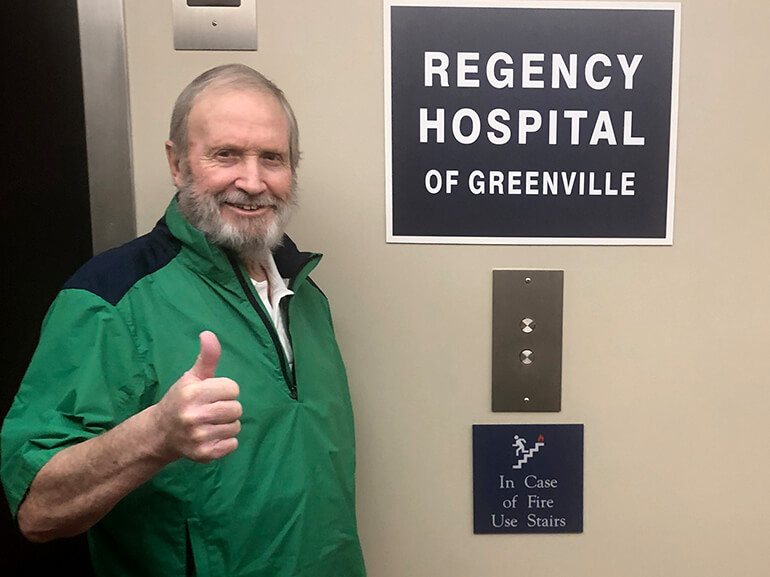Art's Story

An independent man, restored
For 40 years, Art Brooks has run appraisal and real estate companies around Easley, South Carolina. As the owner and broker-in-charge of ABC Realty, he manages a broad swath of properties in the region.
The active 72-year-old still does a lot of maintenance work himself. In mid-January, while at an apartment building, Art grew weak and dizzy. He drove himself home and went to bed.
In the middle of the night, he awoke confused. His wife of 50 years, Gwen, a retired nurse, took his temperature. It was alarmingly high. She dialed 911 and an ambulance rushed him to the emergency room.
Gwen feared a heart attack, but tests determined he’d contracted methicillin-resistant staphylococcus aureus (MRSA), blood stream infections and was in respiratory failure. Doctors placed a breathing tube temporarily and started several, powerful intravenous medications.
After three weeks in the hospital, Art no longer needed a breathing machine but was profoundly weak. He required prolonged intravenous antibiotics and cardiac monitoring for a newly diagnosed arrhythmia. After researching options, Gwen had Art admitted to Regency Hospital of Greenville for its experience helping patients with complex medical conditions begin their recovery.
“When I understood the nature of my illness, I wanted to do everything possible to get home,” Art said.
He arrived in early February, with a goal of getting back to his business and independent life.
“Regency was the turning point,” Art said. “It was the beginning of all the positive things that happened to me and my family.”
A physician-led team of nurses, therapists, dietitians and pharmacists created a plan to help Art meet his goals.
Physical and occupational therapists started with range of motion exercises in the bed. Moving his arms, legs, wrists, ankles and body reinvigorated Art’s muscles. He progressed to sitting at the bed’s edge and standing. He reached a milestone when he stood up and tried walking for the first time.
“I realized I could do it,” he said.
He advanced to walks in the hall and navigated a set of stairs with his physical therapist nearby.
Through it all, Gwen, their son and grandchildren, and Art’s family and friends were a constant source of support. They called, sent pictures and cards and, because his hospitalization occurred before the coronavirus pandemic descended on the United States, visited frequently.
Art, who enjoys music, “clicked” with one of his physical therapy assistants. Together, they sang their way through exercise sessions.
Respiratory therapists led Art through deep breathing and chest exercises to build stamina and lung strength. A registered dietitian coordinated a meal plan rich in healing nutrients and calibrated to give him enough energy to get through therapy. Pharmacists and nurses monitored his antibiotic therapy, drew blood for lab work and ascertained when the infections had cleared.
Art praised the certified nursing assistants who helped him bathe, take care of personal needs and made the bed. They always had a smile and kind word, he said, and it made all the difference.
One month to the day after arriving, Art was ready to go home. He’d met all his goals and was looking forward to getting back to the daily routine.
He planned to go fishing with his son and grandson on the family’s pontoon boat, return to work and enjoy lots of time with his extended family.
“If you don’t know about this hospital, go online and find out,” Art said. “It could be a life-saver for you the way it was for me.”